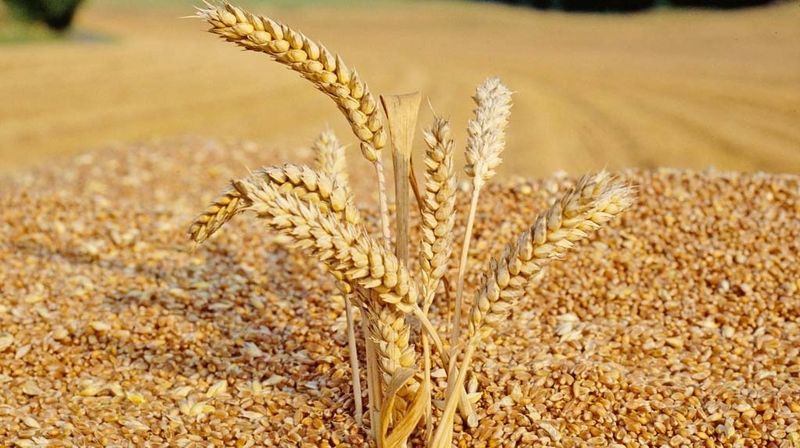Pakistan’s Wheat Production Slumped Due To Water Shortages In FY22

The cultivated area of wheat decreased to 8,976 thousand hectares (2.1 percent) during 2021-22 as compared to the last year’s cultivated area of 9,168 thousand hectares. The production of wheat declined to 26.394 million tonnes (3.9 percent) compared to the 27.464 million tonnes production of last year. Wheat production declined due to a decline in area sown, a shortfall in irrigation water and drought conditions at sowing, lesser fertilisers off-take, and heat wave in March/April, though the government has increased the Minimum Support Price to Rs. 2200/40 kg this year is aligned to the cost of production. During 2021-22, the cropped area of cotton declined to 1,937 thousand hectares (6.8 percent) against last year’s 2,079 thousand hectares. Cotton production increased to 8.329 million bales (17.9 percent) against last year’s 7.064 million bales mainly due to improved yield. The improvement in cotton yield was attributed to conducive weather conditions, smooth input supplies, better crop management practices, and favorable cotton prices in the international and domestic markets.
During 2021-22, sugarcane was cropped on 1,260 thousand hectares and recorded an increase of 8.2 percent compared to last year’s sown area of 1,165 thousand hectares. The sugarcane crop recorded bumper production of 88.651 million tonnes during 2021-22, up by 9.4 percent over last year (81.009 million tonnes). The higher domestic sugar price and better sugarcane procurement price incentivized growers to dedicate more area to sugarcane. The favorable weather conditions, better management, and timely availability of quality inputs also played their part.
Rice was sown on 3,537 thousand hectares during 2021-22, showing an increase of 6.1 percent as against 3,335 thousand hectares last year. The record-high output of rice stood at 9.323 million tonnes during 2021-22, higher by 10.7 percent than last year’s production of 8.420 million tonnes. The maize crop was sown on an area of 1,653 thousand hectares and recorded an increase of 16.6 percent during 2021-22 over last year’s cultivated area of 1,418 thousand hectares. Maize crop output was recorded at 10.635 million tonnes witnessing a significant growth of 19.0 percent over 8.940 million tonnes last year.
2.754 million tonnes of edible oil/oil from oilseed for crushing total value of Rs. 662.657 billion ($3.681 billion) was imported during the first nine months of the current fiscal year. Local production of edible oil during this period is provisionally estimated at 0.460 million tonnes. The total availability of edible oil during this period is estimated at 3.214 million tonnes.
The gram production grew by 36.3 percent and reached 319 thousand tonnes on account of the availability of certified seeds and favorable weather conditions during 2021-22 compared to last year. The production of rapeseed & mustard increased by 26.7 percent while production of Jowar and Bajra witnessed a decrease of 33.3 percent and 15.0 percent, respectively, due to a decline in area under cultivation. The production of Barley and Tobacco remained at the last year’s production level. The production of chillies, potato, and moong increased by 36.6 percent, 35.1 percent, and 29.0 percent, respectively, as compared to the same period of last year. However, the production of mash and onion declined by 11.6 percent and 8.5 percent, respectively, while production of masoor remained the same over last year.
During the monsoon season (July-September) 2021, rainfall was recorded at 125.0 mm showing a decline of 11.3 percent against the normal average rainfall of 140.9 mm. During the post-monsoon season (October-December) 2021, rainfall stood at 23.5 mm against the normal average rainfall of 26.4, showing a decrease of 11.2 percent. During the winter season (January-March) 2022, rainfall was recorded at 72.7 mm against the normal average rainfall of 74.3 mm, showing a decrease of 2.2 percent. Canal head withdrawals decreased by 0.05 percent during Kharif (April-September) 2021 and reached 65.08 MAF compared to 65.11 MAF during the same season last year. During Rabi (October-March) 2021-22, it recorded a decline of 12 percent to 27.42 MAF compared to 31.21 MAF during the same season last year.
Read also
Wheat in Southern Brazil Impacted by Dry Weather and Frosts
Oilseed Industry. Leaders and Strategies in the Times of a Great Change
Black Sea & Danube Region: Oilseed and Vegoil Markets Within Ongoing Transfor...
Serbia. The drought will cause extremely high losses for farmers this year
2023/24 Safrinha Corn in Brazil 91% Harvested
Write to us
Our manager will contact you soon



